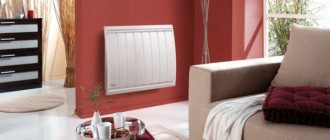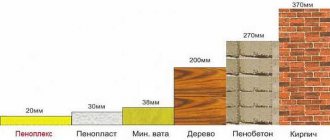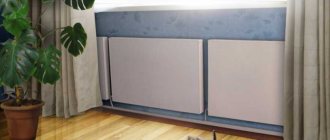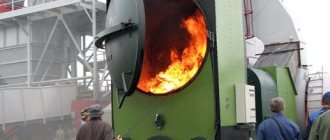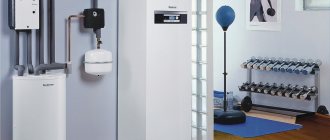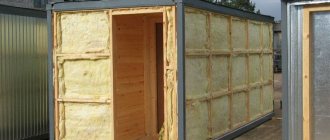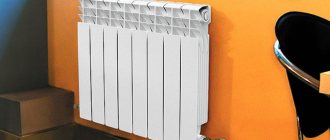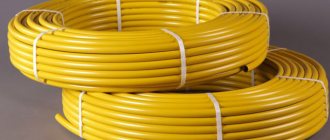Infrared heaters are heating devices that transfer the heat they produce to surrounding objects through infrared radiation. This radiation, like sunlight, is invisible, is not absorbed by the air and reaches the lower part of the room without loss, warming up the floor, furniture, walls and interior elements located in the coverage area of the device. In infrared heaters, up to 90% of the energy is converted into a stream of long-wavelength heat rays and only 10% is spent on heating the air next to the heater.
Thus, the heat from the infrared heater is distributed evenly throughout the entire radiation zone, does not depend on air flows and ceiling heights, and creates comfortable conditions for people by heating the floor, and not the air at head level. Thanks to this principle of operation, an infrared heater can be used where another heating method is difficult, impossible or economically unjustified: in rooms with very high ceilings or large heat losses (ventilated, heavily glazed, etc.); in semi-open and open verandas, terraces, halls; on open air; in rooms where zonal or even spot heating is needed. Other advantages of infrared heaters include efficiency, convenience, safety, ease of use and maintenance, compactness and noiselessness.
A wide range and range of uses means that for each specific case of installing an infrared heater, it is necessary to make a calculation and select the device model that will optimally satisfy the heat needs. A model for an industrial warehouse, an open pavilion or a small cafe will differ significantly in characteristics.
How to choose an infrared heater?
The choice of heater will depend on several main criteria:
- type of premises (residential, office, trade pavilion, warehouse, etc.)
- heating options (full, additional, zone, spot, etc.)
- installation heights (ceiling heights),
- installation (ceiling, wall, built-in)
- distances to people present in the room
- energy source (electricity, hot water, liquefied gas, diesel)
[my_custom_ad_shortcode1]
Case and manufacturer
Today you can buy a ceiling infrared heater, manufactured in Europe or domestic. Western samples cost more and are considered to be of higher quality. It is necessary to take into account that many European companies have factories in China, and now components in most cases are purchased there. Therefore, when purchasing, be sure to pay attention to the country of manufacture. Domestic analogues often cost less and are of higher quality.
There are models with steel and aluminum bodies on the market. The latter are lighter and look prettier, but the steel body is more reliable. When making a heater, paint is usually not used, since it quickly deteriorates when exposed to high temperatures.
In this case, you need to pay attention to the presence or absence of rust stains on the surfaces. If such a defect is noticed, then over time stains will appear on the visible side, moreover, such a heater will fail faster.
Source: https://1popechi.ru/
Power of infrared heaters
Having first determined the total power for heating the room as a whole, you can then select the power and number of heaters needed to distribute heat evenly in the room. In order to calculate how much heater power is needed for your room, the power density is calculated (the amount of power per square meter of heated area), which is measured in W/m2. The table shows approximate power densities
to achieve the desired temperature in rooms with different thermal insulation. The temperature indicated in the table may seem insufficient, but it should be remembered that with infrared heating, the ambient temperature feels 3-4° C higher than it actually is.
[my_custom_ad_shortcode2]
Absorption
Infrared radiation can be reflected, absorbed and conducted. There is a simple arithmetic relationship between these 3 stages that adds up to 1 or 100%. 1 or 100% is otherwise called an absolute black body. A completely black body is a physical body that, at any temperature, absorbs all electromagnetic radiation incident on it in all ranges. Thus, an absolutely black body has an absorptivity of 1 for radiation of all frequencies, propagation directions and polarizations.
Radiation = Reflection + Absorption + Transmission.
Heating area of infrared heaters
Infrared heaters are usually mounted on walls or ceilings so that the radiation flux is directed as much as possible towards the heating objects. For large rooms, it is important that the heaters are distributed evenly along the entire perimeter, without creating cold or overheated zones. In order to calculate the required number of devices based on the area of the room, you need to take into account the heating area from one device, depending on the height and method of its installation.
None Ceiling mounting:
[my_custom_ad_shortcode3]
Operating principle of IR rays
In nature, IR rays are one of the spectrum of sunlight. This is the lowest frequency radiation zone. Due to the influence of infrared rays on the surface of our planet, we receive heat. This radiation passes unhindered through the atmosphere and reaches the ground. Absolutely all physical bodies are capable of absorbing infrared radiation. The air receives heat in a secondary manner from bodies that have warmed up. In this case, the second law of thermodynamics applies, which states that a colder body absorbs energy from a warmer one. It doesn't take a great scientist to understand why the air is cooler at night than during the day. The same principle of operation is observed in IR heating elements, which are included in the design of installations for home and industrial use.
Of course, the radiation spectrum of artificially manufactured IR heaters is not as wide as that of natural rays. Man-made IR devices operate in the spectrum range λ = 50-2000 µm. In this case, it is also taken into account that the lower the temperature of the body that can be heated, the longer the IR wave. Depending on the wavelength, infrared radiation is divided into three categories:
- short-wave: λ = 0.74-2.5 µm,
- medium wave: λ = 2.5-50 µm,
- long-wave: λ = 50-2000 µm.
Heating devices work best if they operate in the long-wave spectrum. Various options for IR heaters are the main elements included in the design of IR heating equipment. Based on the fact that the operation of such devices is based on the emission of IR waves, the partings themselves are considered emitters.
Types of infrared heaters
Let's consider the main types of infrared heaters from the point of view of their use in certain rooms. Infrared heaters with halogen lamps (for example, Ballu BHH/M b AEG IR Comfort), having a surface temperature of about 2200 °C, and heaters with open tubular elements (heating elements) with a surface temperature of about 750 °C provide a highly targeted, highly intense heat flow and The nature of heating is similar to a fireplace or fire. Therefore, the optimal application for this type of infrared heaters would be: • premises with high ceilings (trade pavilions, workshops, hangars), • open and semi-open verandas, areas (for example, summer verandas of a cafe or a tent for an “open air” event) • local/zonal heating (for example, a workplace in a large warehouse). Panel-type infrared heaters (for example, Timberk TCH A1N) have a surface temperature from 90 to 400 ° C and can be used from small residential and domestic premises to large offices, industrial buildings and production workshops.
[my_custom_ad_shortcode5]
Quartz emitters
This type of emitters acts with heat on surrounding surfaces without wasting energy in the air space. The beams are delivered in the medium wavelength range. A high-resistance coil located inside the quartz tube allows the heater to quickly reach the specified operating mode and quickly drop the temperature. Due to this, with cyclic methods of processing products at high temperatures, it is possible to significantly save electricity. Often, quartz tubes are installed in vacuum and thermal forming equipment, IR dryers and heat shrink machines. The terminals for connection to the network are located at both ends of the tube. The connection can be made with bolts or heat-resistant wires. The manufacturer can apply ceramic beads to the wires for thermal protection. This does not affect the flexibility of the outputs. To focus the beams and direct them in the right direction, quartz tubes can be enclosed in a steel reflector.
Application options for infrared heaters
The diagrams show options for using infrared heaters for specific rooms using examples of infrared heaters from the popular Swedish company Frico. Thus, in order to calculate and select an infrared heater, you need to know the area of the room that is planned to be heated, the height of the ceilings, the features of thermal insulation, and the location of people in the room.
Remember that if a room with high humidity (car washes, workshops, garages, etc.) you must choose infrared heaters with a high protection class (for example, Timberk Hawaii). For fire-hazardous premises, panel-type heaters with a low surface temperature without open lamps and heating elements are more suitable. For rooms with an exacting design, panels built into the ceiling are recommended, almost invisible in the interior. For open and semi-open spaces, it is advisable to choose models with increased corrosion resistance (for example, AEG IR Comfort 24). To heat areas near windows or display cases, it is recommended to choose models with higher power than for areas in the back of the room.
For easier control of a large number of devices installed around the entire perimeter of the room, you can choose models that are combined into a heating system with one control unit for all heaters (for example, Frico Elztrip EZ).
These recommendations for choosing infrared heating are of a general nature and cannot take into account all the features of your actual operating conditions. For advice and calculations, please contact our specialists. Was the information useful? Share it on your social network:
[my_custom_ad_shortcode6]
Heating element insulator
Since during operation the heater can heat up to 90 degrees or more, it is very important to use a high-quality insulator.
Recently, more and more models are being produced with basalt insulator. It is very important that it is of a type that is acceptable for use in the food industry, then it will definitely be safe. The corresponding mark is placed in the quality certificate, which you can and should ask the seller for.
The range of infrared heaters at ThermoMir:
When designing room heating with ceramic infrared heaters, the main parameter for determining heater models and their quantity is power density. One of the features of heating rooms using infrared heaters is that in such rooms people get the impression that the air temperature is 3-4°C higher than it actually is. Approximate values of the power density required to achieve and further maintain indoor air temperature are presented in the table below.
| Thermal insulation of the room | Power density, W/m | |
| 13 °C | 16 °C | 19 °C |
| Good thermal insulation of the room. | ||
| Poor thermal insulation of the room. | ||
| Non-isolated room. | ||
| The room is semi-open. |
The installation of the ELCER infrared heater must be carried out in such a way that the flow of infrared radiation is directed towards the heated object, and the coverage of the heating area must be uniform. Recommended installation height for heaters: from 2.5 m to 3.5 m. The coverage area of one heater, depending on the mounting method and installation height, is shown in the table below.
| Wall mount | |||
| Installation height. | 2.5 m | 3.0 m | 3.5 m |
| Heated area. | 8 m | 20 m | 40 m |
| Ceiling mount | |||
| Installation height. | 2.5 m | 3.0 m | 3.5 m |
| Heated area. | 17 m | 24 m | 32 m |
An example of calculation and placement of ceramic infrared heaters. It is necessary to heat a workshop with dimensions: length - 10 m, width - 5 m, area - 50 m2. A room with poor thermal insulation. The expected room temperature is 16 °C.
Solution: For a room with poor insulation and an expected temperature of 16 °C, the power density will be 120 W/m2. Recommended mounting of heaters: wall. The installation height of the heaters is 3 m. The power required to heat the room (P) in this case is calculated as follows: P = 50 m2 x 120 W/m2 = 6000 W. Required quantity of ceramic infrared heaters ECL-1000: 6 pcs. In this case, it is recommended to place infrared heaters as shown in the figure:
EXAMPLE OF CALCULATION OF RADIATION POWER AND INSTALLATION OF INFRARED HEATERS The main parameter when designing heating based on infrared heaters is the determination of power density (the amount of power per square meter of heated area), measured in W/m2. Below are the approximate values of the required power density to achieve a given temperature in rooms with different thermal insulation.
| Room type | Power density, W/m2 to reach temperature | |
| 13 0C | 16 0C | 19 0C |
| A room with good thermal insulation | ||
| Room with poor thermal insulation | ||
| Non-insulated room | ||
| Semi-open space |
When choosing power density, it should be taken into account that infrared heating creates the feeling that the ambient temperature is 3-4° C higher than it actually is.
Infrared heaters are installed on walls or suspended from the ceiling so that the radiation flow is directed at the heated object. Here are the recommended distances from surfaces when installing heaters. Coverage of the heated area must be uniform to achieve uniform power density.
Recommended installation height for heaters: from 2.5 m to 3.5 m. Below is the coverage area of one heater in m2 depending on the mounting method and installation height.
| Wall mount | |||
| Installation height. | 2.5 m | 3.0 m | 3.5 m |
| Heated area. | 8 m2 | 20 m2 | 40 m2 |
| Ceiling mount | |||
| Installation height | 2.5 m | 3.0 m | 3.5 m |
| Heated area | 17 m2 | 24 m2 | 32 m2 |
EXAMPLE OF CALCULATIONS AND PLACEMENT OF RADIATORS.
- Workshop room dimensions: 10m long, 5m wide, area 50 m2, with poor thermal insulation, expected temperature - 16 0C.
- The power density will be 120 W/m2, wall mounting, installation height – 3m.
- Total power: 50 m2 x 120 W/m2 = 6000 W.
- Number of radiators EIUS 212: 6 pcs. Placement of radiators as in the figure:
The consumption of infrared heating is low. Want to know how much electricity an IR heater consumes? Much less than electric boilers, gas boilers, oil heaters, air heaters, fan heaters. Now you know how much energy infrared heaters consume. Infrared heating devices, infrared heating lamps, warm ceilings, warm floors - all this can be purchased and even ordered for installation.
[my_custom_ad_shortcode1]
Process temperature control
Process control without feedback
- This is when the infrared radiation source, gas or electric, is set to a percentage of full power. This is similar to a regular electric or gas cooker where you have low, medium or high settings. The control system does not receive information about the actual temperature of the heater or product.
In process control with feedback
a measuring device such as a thermocouple is used. Closed-loop control systems can automatically compensate for changes in ambient temperature, changes in inlet product temperature, and fluctuations in line voltages in electrical systems.
For non-critical processes, where the acceptable product temperature may range from 14 to 28 o C, open loop control is more cost effective and can provide sufficient product control and process repeatability. Where tight temperature control is required, for example less than 5 ø C, closed loop control is the preferred choice.
Combined systems can be used where the first part of the process is open-loop controlled to raise the product to a common temperature range, and the last part of the system is closed-loop, providing the desired final temperature tolerance and repeatability for the entire process.
The installed (required) heating power is calculated using the formula:
W=S*K where: W — installed power, W; S —heated area, m2; K - required power per 1 m² depending on the building, W/m2:
| Type of heated room | TO |
| New residential building | 60 W/m2 |
| Old residential building | 70–90 W/m2 |
| Cottage | 70–80 W/m2 |
| Timber house | 80–90 W/m2 |
| Pavilion | 100–120 W/m2 |
| Shop | 80–100 W/m2 |
| Warehouses | 50–60 W/m2 |
| Office rooms | 60–90 W/m2 |
[my_custom_ad_shortcode3]
Annual electricity consumption is calculated using the formula:
Agod=24h*W*N*Ki*(Tin-Tcred)/(Tin-Tcrit) , where: Agod - annual electricity consumption, kW*hour; N is the number of days of the heating period; Ki is the heating system utilization factor:
- for a residential building without automatic air temperature control Ki=0.9;
- for a residential building with automatic air temperature control Ki=0.6;
- for an industrial building without automatic air temperature control Ki=0.7;
- for an industrial building with automatic control of air temperature Ki=0.5;
Tinut - the required internal temperature in the building; Tavg —average outdoor air temperature during the heating period; Tcrit is the minimum (critical) outside air temperature during the heating period.
[my_custom_ad_shortcode4]
An example of individual calculation of infrared heating
We will carry out a thermal calculation of a typical capital three-room house with a total area of 50 m², with the installation of an automatic air temperature control system for the city of Chelyabinsk, where the critical temperature is -39°, the average outdoor air temperature during the heating period is -6.5° and the heating period is 218 days. The required room temperature is 20 °C. Thus, the installed power for this house will be equal to W = 50 m² * 70 W/m2 = 3,500 W
[my_custom_ad_shortcode5]
Specifications
Infrared heaters have different technical characteristics . Manufacturers are trying to improve both the emitter itself and additional functions. Additional options include, first of all, active safety systems, such as automatic shutdown in the event of an emergency or overload, operating mode in a system of interconnected devices, the ability to connect a thermostat or a smart home system for remote or completely autonomous control of the device.
Some models boast an elegant design and a thin front panel that will fit perfectly into any interior.
Built-in infrared film heaters
Monthly costs will be:
Mix = 8684/ 218 * 30.5 = 1215 rub . The cost of heating 1 m² per month will be: Ci= 1215 / 50 = 24.30 rubles.
The calculation is valid for residential buildings that comply with SNiP 03 “Thermal protection of buildings”, with a ceiling height of no more than 3 meters (the infrared heating system reaches operating mode from 2 to 14 days). The data from the calculation coincides with many years of practice in operating an infrared heating system. Thus, the cost of heating with infrared heaters is comparable to the cost of heating with water gas and central heating, and when using programming it can be significantly lower.
[my_custom_ad_shortcode3]
Carbon lamp
Structurally, it is a quartz tube with a vacuum medium, inside of which a radiating element is placed. The emitter consists of several carbon fibers assembled into a bundle and has an increased irradiation area. When the heater is turned on, the fiber instantly gains temperature and generates radiant heat. Consuming the same power as nichrome heaters, the carbon heating element is capable of delivering higher temperatures. On the upper section of the heating element there are switches that regulate the operating mode of the device. Rotation is provided by an electric drive, which is located on a special heater stand. Thus, the heating area can be significantly increased.
